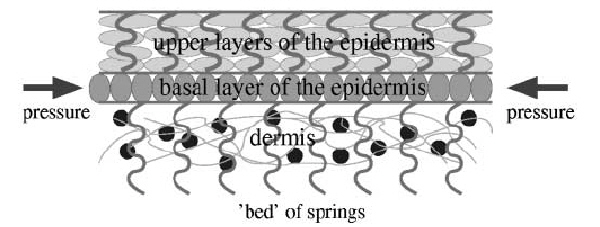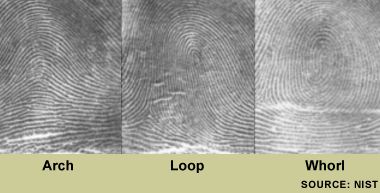Lasting Impression: How Fingerprints are Created

Criminal behavior is often blamed on childhood events. But the ability to catch a thief is rooted in development that occurs in the womb.
By the 17th week of pregnancy, the fingerprints of a fetus are set in stone, observations show. The uniqueness of fingerprints has been recognized for some two millennia and studied scientifically for two centuries. But researchers have not been able to explain how they form.
A new theoretical computer model describes how the patterns are likely created, beginning in the 10th week of gestation, when a fetus is about 3 inches (80 mm) long.
Early signs of stress
Fingerprints involve three distinct features: arches, loops and whorls.
Michael K?cken and Alan Newell of the University of Arizona found that creation of the patterns involves stresses in a sandwiched sheet of skin called the basal layer. In a fetus, the basal layer grows faster than surrounding layers -- the epidermis on the outside and the inner dermis. The basal layer buckles and folds in several directions, forcing complex shapes.
Stresses are created at skin boundaries, including fingernails and knuckle creases, as well as around shrinking fingertip pads, K?cken and Newell report in an October issue of the journal Europhysics Letters.
Get the world’s most fascinating discoveries delivered straight to your inbox.
"These folds encode the future fingerprint pattern that becomes visible on the skin surface in subsequent weeks," K?cken told LiveScience. "Because the fingerprint pattern is coded underneath the skin surface, the pattern cannot be destroyed by superficial skin injuries."
Exactly, how the pattern is preserved during growth of the fetus is still unclear, he said.
The model confirms an 80-year-old explanation that had never gained acceptance.
Strange skin
Fingerprints are strange to scientists. In fact, the palms of the hands are mysteriously different from the rest of the body in several ways.
"Not only are there fingerprints on the palm and not on other places of the skin, but the skin is also thickest on the palm, there are more sweat glands and there are no hair follicles," K?cken points out. He said the same buckling process might be responsible for the formation of brain grooves, certain structures in the eye and even -- though this is highly speculative -- hair follicles.
Many designs in Nature are mathematically similar to fingerprints.
Sand dune ripples, stripes on tropical fish, and patterns of a convecting fluid are but a few, K?cken said.
One similar phenomenon, known as a von Karman vortex, occurs when currents of air or liquid move in opposite directions. The process can create fantastically curled clouds. Insects borrow energy from von Karman vortices created by their own wings to improve speed and maneuverability.
The diverse patterns are not all created by the same mechanism, K?cken said, but they can be described by similar equations. That similarity makes it very difficult to locate the physical mechanism behind each, especially with highly complex biological patterns.
"Our research strongly suggests that mechanical instabilities are involved in at least some of these circumstances," K?cken said. "Further, there is currently a discussion on whether fingerprint evidence should still be valid in court. Although our model, as it is, does not have any direct implications for fingerprint identification it could help to provide a more solid foundation of the subject in the future."
Robert is an independent health and science journalist and writer based in Phoenix, Arizona. He is a former editor-in-chief of Live Science with over 20 years of experience as a reporter and editor. He has worked on websites such as Space.com and Tom's Guide, and is a contributor on Medium, covering how we age and how to optimize the mind and body through time. He has a journalism degree from Humboldt State University in California.




